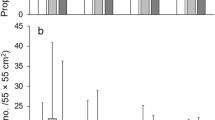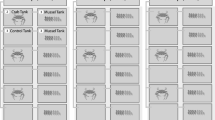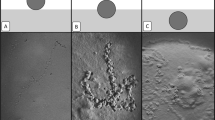Abstract
Soft sediment shores in the tropics are highly dynamic environments, where behavioural patterns of organisms are constrained by tidal conditions, and environmental temperatures during an organisms’ activity periods can exceed their thermal tolerance levels. In such extreme habitats, behavioural responses to environmental changes are key to survival, driving differential performance. We investigated sponging behaviour (water uptake from sediments) of the deposit-feeding crab, Scopimera intermedia, on tropical sandy shores to determine its thermoregulatory function. The thermal physiology of the crabs and their habitat conditions were quantified by measuring thermal performance curves and recording environmental temperatures during the crabs’ activity periods. Environmental temperatures were combined with experimental data to investigate the role of sponging on the thermal performances of the crabs by simulating field body temperatures. Sponging rate was strongly and positively correlated with feeding rate, as sponging replenishes water for flotation feeding. Sponging, however, also reduced body temperatures on average by 1.3 °C. Simulated populations of crabs which were unable to sponge had more variable body temperatures, which exceeded the critical thermal maximum of the crabs (~ 39 °C) nearly 2000 times more often than crabs able to sponge. Sponging is, therefore, a multifunctional behavioural trait important for both feeding and thermoregulation. The evolution of such multifunctional traits is likely to be a widespread, but overlooked phenomenon in intertidal species, as maintaining a functional body temperature is energetically costly in habitats where environmental conditions fluctuate strongly such as on tropical shores.





Similar content being viewed by others
References
Alibardi L (2003) Adaptation to the land: the skin of reptiles in comparison to that of amphibians and endotherm amniotes. J Exp Zool B Mol Dev Evol 298:12–41
Allen BJ, Levinton JS (2014) Sexual selection and the physiological consequences of habitat choice by a fiddler crab. Oecologia 176:25–34
Allen BJ, Rodgers B, Tuan Y, Levinton JS (2012) Size-dependent temperature and desiccation constraints on performance capacity: implications for sexual selection in a fiddler crab. J Exp Mar Biol Ecol 438:93–99
Andersson M (1982) Female choice selects for extreme tail length in a widowbird. Nature 299:818–820
Angilleta MJ (2009) Thermal Adaptation: a Theoretical and Empirical Synthesis. Oxford University Press, New York
Aronson J, Kigel J, Klein SJ (1992) Adaptive phenology of desert and Mediterranean populations of annual plants grown with and without water stress. Oecologia 89:17–26
Bennett AF, Huey RB (1990) Studying the evolution of physiological performance. Oxf Surv Evol Biol 7:251–284
Bolker BM (2015) Linear and generalized linear mixed models. In: Fox GA (ed) Ecological Statistics: Contemporary Theory and Application. Oxford University Press, New York, pp 309–333
Chang C, Wu P, Baker RE, Maini PK, Alibardi L, Chuong C-M (2009) Reptile scale paradigm: evo-devo, pattern formation and regeneration. Int J Dev Biol 53:813–826
Cloudsley-Thompson JL (1975) Adaptations of arthropoda to arid environments. Annu Rev Entomol 20:261–283
Darnell MZ, Munguia P (2011) Thermoregulation as an alternate function of the sexually dimorphic fiddler crab claw. Am Nat 178:419–428
Darnell MZ, Nicholson HS, Munguia P (2015) Thermal ecology of the fiddler crab Uca panacea: thermal constraints and organismal responses. J Therm Biol 52:157–165
Davies MS, Hawkins SJ, Jones HD (1990) Mucus production and physiological energetics in Patella vulgata L. J Molluscan Stud 56:499–503
Dong Y-W, Miller LP, Sanders JG, Somero GN (2008) Heat-shock protein 70 (Hsp 70) expression in four limpets of the genus Lottia: interspecific variation in constitutive and inducible synthesis correlates with in situ exposure to heat stress. Biol Bull 215:173–181
Dowd WW, King FA, Denny MW (2015) Thermal variation, thermal extremes and the physiological performance of individuals. J Exp Biol 218:1956–1967
Du W, Shine R (2015) The behavioural and physiological strategies of bird and reptile embryos in response to unpredictable variation in nest temperature. Biol Rev Camb Philos Soc 90:19–30
Edney EB (1961) The water and heat relationships of fiddler crabs (Uca spp.). Trans R Soc S Afr 36:71–91
Frost PGH, Siegfried WR, Burger AE (1976) Behavioural adaptations of the Jackass penguin, Spheniscus demersus to hot, arid environment. J Zool 179:165–187
Garrity SD (1984) Some adaptations of gastropods to physical stress on a tropical rocky shore. Ecology 65:559–574
Gherardi F, Russo S, Anyona D (1999) Burrow-oriented activity in the ocypodid crab, Dotilla fenestrata, living in a mangrove swamp. J Mar Biol Assoc UK 79:281–293
Gracey AY, Chaney ML, Boomhower JP, Tyburczy WR, Connor K, Somero G (2008) Rhythms of gene expression in a fluctuating intertidal environment. Curr Biol 18:1501–1507
Halpin PM, Sorte CJ, Hofmann GE, Menge BA (2002) Patterns of variation in levels of Hsp70 in natural rocky shore populations from microscales to mesoscales. Integr Comp Biol 42:815–824
Helmuth B, Hofmann GE (2001) Microhabitats, thermal heterogeneity, and patterns of physiological stress in the rocky intertidal zone. Biol Bull 201:274–384
Helmuth B et al (2014) Beyond-long term averages: making biological sense of a rapidly changing world. Clim Change Respond 1:1–12
Hemmi JM (2005) Predator avoidance in fiddler crabs: 1. escape decisions in relation to the risk of predation. Anim Behav 69:603–614
Hong Kong Observatory (2017) Climatological information services. URL: http://www.hko.gov.hk/cis/climat_e.htm. Accessed 6 Mar 2017
Hood WG, Tschinkel WR (1990) Desiccation resistance in arboreal and terrestrial ants. Physiol Entomol 15:23–35
Huey RB (1974) Behavioural thermoregulation in lizards: importance of associated costs. Science 184:1001–1003
Huey RB, Bennett AF (1990) Physiological adjustments to fluctuating thermal environments: an ecological and evolutionary perspective. In: Morimoto R, Tissières A, Georgopoulos C (eds) Stress proteins in biology and medicine. Cold Spring Harbor Laboratory Press, New York, pp 37–59
Huey RB, Peterson CH, Arnold SJ, Porter WP (1989) Hot rocks and not-so-hot rocks: retreat-site selection by garter snakes and its thermal consequences. Ecology 70:931–944
Huey RB et al (2002) Plants versus animals: do they deal with stress in different ways? Int Comp Biol 42:415–423
Hui TY (2017) Behavioural ecology of the sand-bubbler crab Scopimera intermedia Balss, 1934 in Hong Kong. PhD Dissertation, The Swire Institute of Marine Science and School of Biological Sciences, The University of Hong Kong, Hong Kong
Jayne B, Bennett AF (1990) Selection on locomotor performance capacity in a natural population of garter snakes. Evolution 44:1204–1229
Kaehler S, Williams GA (1996) Distribution of algae on tropical rocky shores: spatial and temporal patterns of non-coralline encrusting algae in Hong Kong. Mar Biol 125:177–187
Kingsolver JG (1987) Evolution and coadaptation of thermoregulatory behaviour and wing pigmentation pattern in pierid butterflies. Evolution 41:472–490
Koga T (1995) Movements between microhabitats depending on reproduction and life history in the sand-bubbler crab Scopimera globosa. Mar Ecol Prog Ser 117:65–74
Landry Yuan F, Pickett EJ, Bonebrake TC (2016) Cooler performance breadth in a viviparous skink relative to its oviparous congener. J Therm Biol 61:106–114
Lee SY (1995) Cheliped size and structure: the evolution of a multi-functional decapod organ. J Exp Mar Biol Ecol 193:161–176
Levinton JS, Lord S, Higeshide Y (2015) Are crabs stressed for water on a hot sand flat? Water loss and field water state of two species of intertidal fiddler crabs. J Exp Mar Biol Ecol 469:57–62
Lutterschmidt WI, Hutchison VH (1997) The critical thermal maximum: history and critique. Can J Zool 75:1561–1574
Macintosh DJ (1978) Some response of tropical mangrove fiddler crabs (Uca spp.) to high environmental temperatures. In: McLusky DS, Berry AJ (eds) Physiology and Behaviour of Marine Organisms. Pergamon Press, Oxford, pp 49–56
Maitland DP (1990) Carapace and branchial water circulation, and water-related behaviours in the semaphore crab Heloecius cordiformis (Decapoda: Brachyura: Ocypodidae). Mar Biol 105:275–286
Marshall DJ, Chua T (2012) Boundary layer convective heating and thermoregulatory behaviour during aerial exposure in the rocky eulittoral fringe snail Echinolittorina malaccana. J Exp Mar Biol Ecol 430–431:25–31
Marshall DJ, Ng TPT (2013) Shell standing in littorinid snails: a multifunctional behaviour associated with mating? J Molluscan Stud 79:74–75
Martin TL, Huey RB (2008) Why “suboptimal” is optimal: Jensen’s inequality and ectotherm thermal preferences. Am Nat 171:E102–E118
Martín J, López P (1999) When to come out from a refuge: risk-sensitive and state-dependent decisions in an alpine lizard. Behav Ecol 10:487–492
Miller DC (1961) The feeding mechanism of fiddler crabs, with ecological considerations of feeding adaptation. Zoologica 46:89–100
Miller PL (1970) On the occurrence and some characteristics of Cyrtopus fastuosus Bigot and Polypedilum sp. from temporary habitats in western Nigeria. Entomol Mon Mag 105:233–238
Morton SR et al (2011) A fresh framework for the ecology of arid Australia. J Arid Environ 75:313–319
Munguia P, Backwell PRY, Darnell MZ (2017) Thermal constraints on microhabitat selection and mating opportunities. Anim Behav 123:259–265
Nagy KA (1994) Seasonal water, energy and food use by free-living, arid-habitat mammals. Aust J Zool 42:55–63
Naylor E (1985) Tidally rhythmic behaviour of marine animals. Symp Soc Exp Biol 39:63–93
Ng TPT et al (2017) Linking behaviour and climate change in intertidal ectotherms: insights from littorinid snails. J Exp Mar Biol Ecol 492:121–131
Norbury GL, Norbury DC, Oliver AJ (1994) Facultative behaviour in unpredictable environments: mobility of red kangaroos in arid Western Australia. J Anim Ecol 63:410–418
Noy-Meir I (1973) Desert ecosystems: environment and producers. Annu Rev Ecol Syst 4:25–51
Padilla DK, Adolph SC (1996) Plastic inducible morphologies are not always adaptive: the importance of time delays in a stochastic environment. Evol Ecol 10:105–117
Palmer JD (1973) Tidal rhythms: the clock control of the rhythmic physiology of marine organisms. Biol Rev 48:377–418
Piersma T, Drent J (2003) Phenotypic flexibility and the evolution of organismal design. Trends Ecol Evol 18:228–233
Powers LW, Cole JF (1976) Temperature variation in fiddler crab microhabitats. J Exp Mar Biol Ecol 21:141–157
Quinn RH (1980) Mechanisms for obtaining water for flotation feeding in the soldier crab, Mictyris longicarpus Latreille, 1806 (Decapoda, Mictyridae). J Exp Mar Biol Ecol 43:49–60
R Core Team (2015) R: A language and environment for statistical computing
Roberts DA, Hofmann GE, Somero GN (1997) Heat-shock protein expression in Mytilus californianus: acclimatization (seasonal and tidal-height comparisons) and acclimation effects. Biol Bull 192:309–320
Schmidt-Nielsen K, Taylor CR, Shkolnik A (1971) Desert snails: problems of heat, water and food. J Exp Biol 55:385–398
Sherbrooke WC, Scardino AJ, de Nys R, Schwarzkopf L (2007) Functional morphology of scale hinges used to transport water: convergent drinking adaptations in desert lizards (Moloch horridus and Phrynosoma cornutum). Zoomorphology 126:89–102
Sinclair BJ et al (2016) Can we predict ectotherm responses to climate change using thermal performance curves and body temperatures? Ecol Lett 19:1372–1385
Somero GN (2005) Linking biogeography to physiology: evolutionary and acclimatory adjustments of thermal limits. Front Zool 2:1–9
Song B et al (2013) Multifunctional bracts enhance plant fitness during flowering and seed development in Rheum nobile (Polygonaceae), a giant herb endemic to the high Himalayas. Oecologia 172:359–370
Stevenson RD (1985) The relative importance of behavioral and physiological adjustments controlling body temperature in terrestrial ectotherms. Am Nat 126:362–386
Sunday JM et al (2014) Thermal-safety margins and the necessity of thermoregulatory behavior across latitude and elevation. Proc Natl Acad Sci 111:5610–5615
Tomanek L (2002) The heat-shock response: its variation, regulation and ecological importance in intertidal gastropods (genus Tegula). Integr Comp Biol 42:797–807
Vernberg FJ (1959) Studies on the physiological variation between tropical and temperate zone fiddler crabs of the genus Uca. II. Oxygen consumption of whole organisms. Biol Bull 117:163–184
Webb JK, Whiting MJ (2005) Why don’t small snakes bask? Juvenile broad-headed snakes trade thermal benefits for safety. Oikos 110:515–522
Weinstein RB, Full RJ, Ahn AN (1994) Moderate dehydration decreases locomotor performance of the ghost crab, Ocypode quadrata. Physiol Zool 67:873–891
Wilkens JL, Fingerman M (1965) Heat tolerance and temperature relationships of the fiddler crab, Uca pugilator, with reference to body coloration. Biol Bull 128:133–141
Williams GA, Morritt D (1995) Habitat partitioning and thermal tolerance in a tropical limpet, Cellana grata. Mar Ecol Prog Ser 124:89–103
Williams GA, De Pirro M, Leung KMY, Morritt D (2005) Physiological responses to heat stress on a tropical shore: the benefits of mushrooming behaviour in the limpet Cellana grata. Mar Ecol Prog Ser 292:213–224
Windsor A, Crowe M, Bishop J (2005) Determination of temperature preference and the role of the enlarged cheliped in thermoregulation in male sand fiddler crabs, Uca pugilator. J Therm Biol 30:37–41
Wolcott TG (1973) Physiological ecology and intertidal zonation in limpets (Acmaea): a critical look at “limiting factors”. Biol Bull 145:389–422
Wolcott TG (1976) Uptake of soil capillary water by ghost crabs. Nature 264:756–757
Wolcott TG, Wolcott DL (2001) Role of behaviour in meeting osmotic challenges. Am Zool 41:795–806
Yao H et al (2010) Protection mechanisms of the iron-plated armor of a deep-sea hydrothermal vent gastropod. Proc Natl Acad Sci 107:987–992
Acknowledgements
The authors would like to thank members of the Hard Rock Ecology Laboratory and Dr Stefano Cannicci at HKU for stimulating discussions; Prof. Jeffrey Levinton (Stony Brook University) and Prof. Matthew Evans (HKU) who gave constructive comments which helped improve this manuscript, and Dr. Pablo Munguia for suggesting modelling the trade-offs between environmental predictability and behavioural/physiological responses to stresses. Dr. Jenny Yuen Yung Lau (HKU) and Dr. Chun Chiu Pang (HKU) helped identify the Sporobolus specimens. This research was supported by HKU Postgraduate Scholarships to TYH and FLY.
Author information
Authors and Affiliations
Contributions
This study was conceived by TYH, FLY, TCB and GAW. TYH conducted 100% of the surveys and experimental work, FLY contributed to the statistical analyses, while FLY, TCB and GAW contributed to writing the manuscript.
Corresponding author
Ethics declarations
Conflict of interest
There is no conflict of interest.
Additional information
Communicated by Pablo Munguia.
Electronic supplementary material
Below is the link to the electronic supplementary material.
Rights and permissions
About this article
Cite this article
Hui, T.Y., Landry Yuan, F., Bonebrake, T.C. et al. Multifunctional behaviour in a sandy shore crab enhances performance in extreme intertidal environments. Oecologia 189, 79–89 (2019). https://doi.org/10.1007/s00442-018-4299-8
Received:
Accepted:
Published:
Issue Date:
DOI: https://doi.org/10.1007/s00442-018-4299-8




